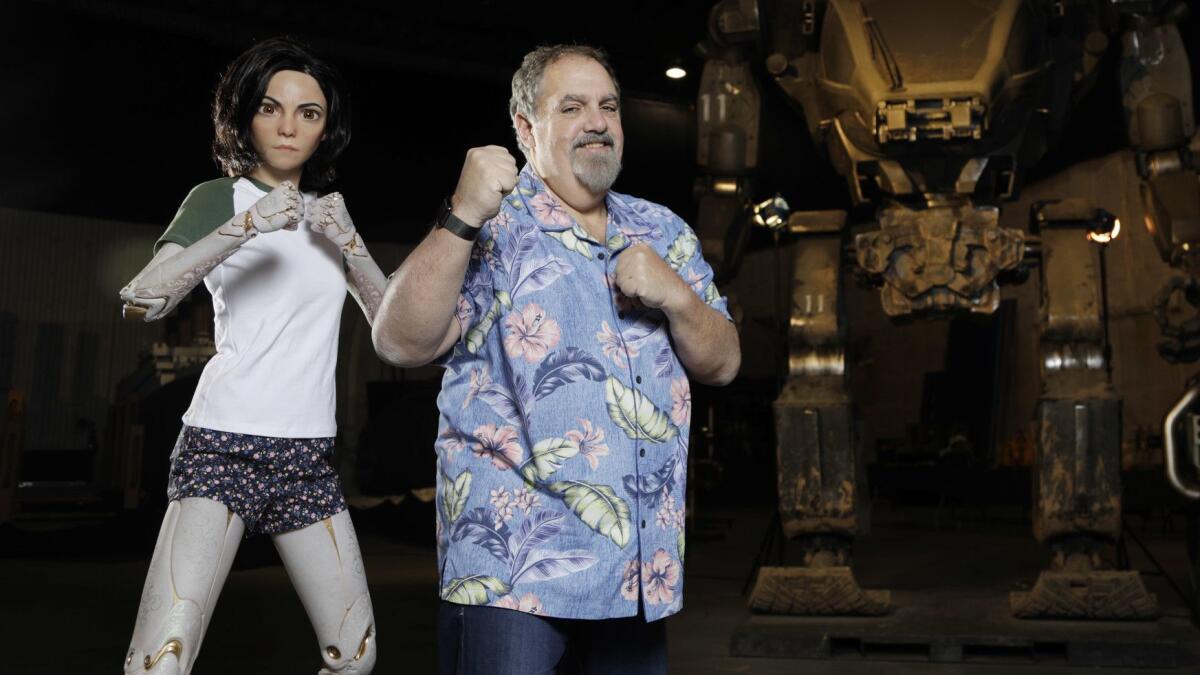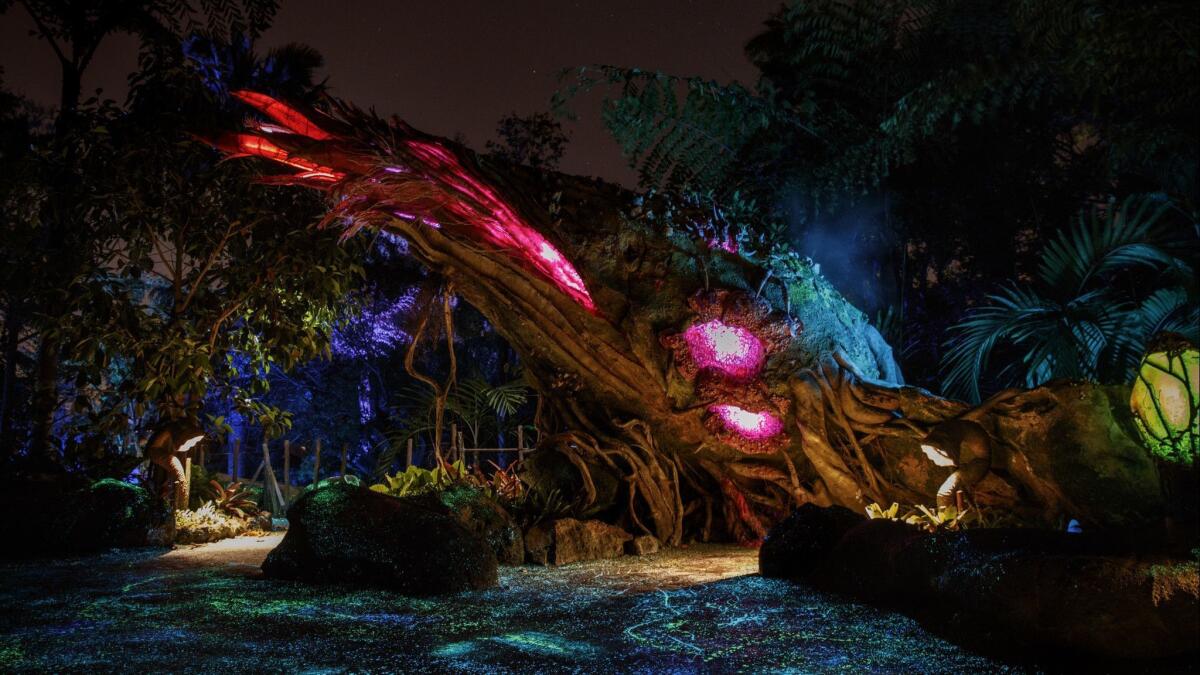How ‘Alita’ is paving the way for James Cameron’s ‘Avatar’ sequels

- Share via
The steely gaze of Na’vi warrioress Neytiri welcomes visitors at the entrance to some of Hollywood’s most wondrous and fantastical worlds. Towering in the corner of a hangar, an “Aliens” xenomorph menaces, frozen in place. Upstairs sits the Heart of the Ocean, daring passersby to never let go.
No, you’re not in Kansas anymore. You’re at Lightstorm Entertainment, the solar-powered, eco-friendly Manhattan Beach headquarters of Oscar-winning “Avatar” filmmakers James Cameron and Jon Landau.
Just a skip away on a massive soundstage, visual effects crews piece together top-secret scenes straight out of Pandora for “Avatar 2.” Oscar-winning VFX artist Richard Baneham tinkers with a “virtual camera,” constructing impossible shots by sending data back and forth to technicians seated at a NASA-like brain trust of computers.
Next door in a custom-built tank filled with 500,000 gallons of water, camera operators in flippers float on pool noodles, ready to shoot an aquatic stunt scene for that aforementioned first of four new “Avatar” sequels set to hit theaters in 2020.
It was here a few years ago that “Sin City” director Robert Rodriguez got a crash course in the groundbreaking immersive 3-D technology he would need to bring the 26th-century dystopia of Iron City to life in PG-13 sci-fi epic “Alita: Battle Angel,” now playing in wide release and adapted by Cameron and Laeta Kalogridis from Yukito Kishiro’s manga series “Gunnm.”
And it’s here today, on a quiet weekday ahead of “Alita’s” domestic debut, that “Avatar” producer Landau leads a private tour through the cutting-edge campus occupying a modest stretch of Manhattan Beach Studios — a much homier base than the Hughes Aircraft space where the first “Avatar” was partially filmed a dozen years ago.
Landau, Lightstorm’s chief operating officer, walks down hallways lined with “Avatar” crew portraits to the “museum” that houses precious artifacts from the company’s mega-blockbusters, tokens of cinematic history that would make any fan’s heart flutter.
Meet Rosa Salazar, the star who lends heart and soul to ‘Alita: Battle Angel’ »
Inside, the Alien queen faces off against Ellen Ripley’s power loader while Sigourney Weaver’s face peers out from a lineup of blue Na’vi busts in the form of her “Avatar” character, Dr. Grace Augustine. Across the room lives the “True Lies” jet; intricately detailed models of the RMS Titanic both pre- and post-iceberg; and the 1912 replica Renault Town Car whose rear window, to this day, bears the steamy hand print that commemorates Rose and Jack’s doomed love.
As Marie Kondo might say, just about every piece seems to spark joy in Landau.
The latest addition to the museum and to the Lightstorm family is also a crucial bridge between the company’s past and its future: A life-size model of Alita, the cyborg heroine played under a digital layer of performance-captured VFX by Rosa Salazar, who wakes up with a new mechanical body and no memory of her past life in the futuristic adventure “Alita: Battle Angel.”
Cameron and Landau had tried to make “Alita” for almost two decades before bringing Rodriguez on to direct. “People say to me, ‘Are you glad you waited this long for the technology?’” says Landau. “And I say, ‘No — I’m glad we waited this long, because we found Rosa.’”
Salazar’s vibrant performance beats at the heart of “Alita.” But the film boasts a hefty price tag reportedly pegged at $170 million. Although Salazar and “Alita’s” VFX have garnered praise, critical reaction has been mixed, and modest opening weekend projections suggest “Alita” could be in for a formidable box office battle.
A few days later, Landau says the box office chatter doesn’t faze him. “Every movie has to stand on its own. You don’t sit there and think every movie is going to be ‘Avengers,’ but that doesn’t mean you don’t go make movies.”
What matters, he says, are the early-screening fans for whom the film has connected strongly. And he’s bullish on the international performance, where “Alita” opened to a “promising” $32 million in 11 markets and has yet to hit China.
“We are in a global industry. We have recognized that from ‘Titanic’ on,” says Landau, preparing to take “Alita” on an international tour with stops in Japan and China where audiences are more familiar with the source material. “You can’t make movies just for North America or just for domestic box office. You have to make them for a global audience.”
In many ways, all roads at Lightstorm — where even the decor of the state-of-the-art in-house theater is “Avatar”-inspired — lead back to Pandora, and to the lessons and future of Lightstorm’s centerpiece franchise.
“‘Avatar’ was the first film that, in my mind, took motion capture and added the ‘e’ that was always missing — emotion capture,” Landau emphasizes, sitting in his office at Lightstorm. “And that’s why we call it performance capture now. Because we want the emotion of somebody, and not just the motion.”
Perched closest to him is a piece, destined for the Motion Picture Academy Museum, that embodies the bottled-lightning moments he strives for: a sculpture of Zoe Saldana as Neytiri wearing her performance-capture rig from “Avatar.”
Cameron initially co-founded Lightstorm with Lawrence Kasanoff nearly 30 years ago, making it the home for his tentpole films including 1991’s “Terminator 2: Judgment Day” and 1994’s “True Lies.” When Landau joined the company he and Cameron scored their biggest hits to date, along with matching Academy Awards: Record-smashers “Avatar” (2009, $2.8 billion) and “Titanic” (1997, $2.2 billion) remain the No. 1 and 2 globally top-grossing films of all time, respectively.
Eventually Cameron turned his focus to directing all four “Avatar” sequels and handed the “Alita” reins, along with 600 pages of notes and access to his stable of artists and technicians, to Rodriguez, the genre director with indie roots known for shooting, cutting and scoring his own films out of his Austin, Texas-based Troublemaker Studios.
Without Cameron at the helm the budget had to come down, says Rodriguez, who shot the film in 57 days combining performance capture with live-action filming on an expansive, practical Iron City set.
Review: ‘Alita: Battle Angel’ is a surprisingly fun mix of B-movie sci-fi and earnest romance »
“He even said, ‘If I made this movie it would cost twice as much!’” Rodriguez says with a laugh. “It was a perfect blend for this type of movie to feel like we just went whole hog on a Jim Cameron film, with some of the efficiencies that my movies have, so that we could even get the studio to sign off on it.”
It didn’t hurt that the extra wait during the development of “Alita” allowed for the evolution of a more sophisticated performance capture technology. The result is eye-popping Weta Digital visual effects that seamlessly unite Salazar’s dynamic acting with character design straight out of Kishiro’s manga.
Rather than the single-camera standard definition rig used on the first “Avatar,” “Alita” utilized a two-camera, high-definition setup. “If Jim had done this back in 2005,” says Rodriguez, “it would be a very different movie.”
What felt great was not only getting to work with Jim, but that I’m helping contribute to the success of ‘Alita.’
— Robert Rodriguez on using the “Alita” tech
That two-camera “Alita” rig is now being used for performance capture on the “Avatar” sequels, making “Alita” a crucial piece of the experimental pipeline pushing the “Avatar” saga’s VFX forward.
“What felt great was not only getting to work with Jim, but that I’m helping contribute to the success of ‘Avatar,’” Rodriguez says. “It was great to be a part of that — me inheriting tech from ‘Avatar,’ and then them inheriting tech from us.” Landau adds: “I was never worried that it wasn’t possible. Once we did ‘Avatar,’ we knew that we could do ‘Alita.’”
The gregarious producer, who takes a public-facing role at Lightstorm as Cameron focuses on directing the “Avatar” sequels, has seen his share of extraordinary challenges.
Never mind the impossible tasks of persuading suits to sign off on blockbuster budgets or relying on next-level visual effects that don’t yet exist; try walking onto your film set to find that unsuspecting crew members have been poisoned with a PCP-laced lunch.
“Luckily, I did not eat that night,” laughs Landau of the infamous 1996 ordeal that actually happened on location in Halifax, Nova Scotia, during the making of “Titanic,” reliving the event as he strolls out of a cafe where Lightstorm provides vegan meals for hundreds of employees, one of the company’s environmentally-conscious perks.
“Imagine: I am the only sane person in an insane world having to deal with this. It was scary! The only other person who did not eat that night, thank God, was Gloria Stuart.” He shakes his head. “We took 53 people to the local emergency room. We had to film the next day! For me, this was a living nightmare.”
Currently “Avatar 2,” “Avatar 3” and parts of “Avatar 4” have completed “principal capture,” with live-action filming set to take place in New Zealand this spring. Cameron, who was unavailable for comment, is constantly sending dailies to Weta that can take up to 10 months to get back, “so we have to keep feeding the beast. And Jim’s in the beast-feeding mode.”
Inside the production building where much of Lightstorm’s day-to-day business takes place, in his own office decorated with movie posters and an undersea painting that reminds him of the diving hobby he loves, Landau considers why their partnership has worked over the years.
“What I’ve found about Jim is that Jim always hears,” says Landau. “In the specific moment he might not listen, but he hears. And he thinks about it and has this amazing ability to process the best answer out of all the information that’s been given to him.”
The producing partners aren’t afraid to challenge each other, Landau says. And as artists working within a studio system that tends to play it safe, they have a simpatico outlook on taking big leaps.
“First and foremost I’d say he’s an explorer,” adds Landau. “And when you’re an explorer you’re a little bit like Lewis and Clark — you’re going to a place where people haven’t gone to before. … You can’t have all the answers before you start it. You have to be able to take that leap of faith to accomplish something.”
Landau was raised in New York by filmmaker parents Ely and Edie Landau (“The Pawnbroker,” “Long Day’s Journey into Night”) who produced “what they would call ‘artsy-fartsy’ movies,” he says with a smile. A poster for one of their films, the Oscar-nominated 1970 Martin Luther King Jr. documentary “King: A Filmed Record … Montgomery to Memphis,” hangs framed on the wall opposite his desk. “What I now realize is that because I was exposed to it, they taught me the importance of storytelling,” he says.
While “Alita” (which costars Christoph Waltz, Jennifer Connelly, Mahershala Ali and Keean Johnson) leaves the door open for future sequels, Landau insists that Lightstorm is not actively planning more installments — at least, not yet.
Once upon a time skeptics thought blue aliens wouldn’t connect with audiences, let alone make billions of dollars. By the time “Avatar 2” hits theaters 11 years will have passed since the first film. Who needs to rush into things?

A visit to Disney’s Pandora — what we learned »
”We want audiences to tell us if they want a sequel,” says Landau. “We have a gift, that Yukito Kishiro created a vast world in which Alita’s character grows through these stories that he sent her on. If audiences tell us that they want a sequel, we know places we can go.”
“We weren’t making ‘Avatar’ to make sequels,” he adds. “We were making ‘Avatar’ to make ‘Avatar,’ and I think you have to look at every movie that way. If audiences say, ‘We want to go back to that world,’ and ‘We want to go back to that character,’ more importantly, we’re ready to do that.”
And he’s optimistic about how the Disney-Fox deal will affect the two studio relationships Lightstorm has most closely cultivated: Having made their movies with 20th Century Fox, who will distribute “Alita” as one of its final pre-merger releases, and partnered with Disney on their “Pandora — The World of ‘Avatar’” theme park in 2017.
“We’re sorry that the decision was made to sell the company because it’s been our home,” says Landau. “But if it was being sold, we could think of no better partner for it to be sold to.”
When the trying moments do arise, Landau shares, he has a trick. He takes out his smartphone and opens a Disney World consumer app that shows him real-time wait times for the “Avatar” rides. “On those tough days when we go, ‘What are we doing? And is it worth it?’”
He checks the app in real time to demonstrate. “It’s a two and a half hour wait to get into one, and an hour and 15 minute wait to get into the other,” he smiles. “I go, ‘You know what? We’re doing OK.’ We’re doing something that people want to experience.”

Star Rosa Salazar and director Robert Rodriguez talk about ”Alita: Battle Angel” -- and the new kind of strong female character at its center -- at the Los Angeles Times Video Studio at San Diego Comic-Con.
More to Read
Only good movies
Get the Indie Focus newsletter, Mark Olsen's weekly guide to the world of cinema.
You may occasionally receive promotional content from the Los Angeles Times.











